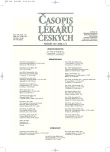Drug Consumption and Risks of Polypharmacotherapy in Elderly Population
Authors:
H. Kubešová; J. Holík; P. Weber; V. Polcarová; J. Matějovský 1; K. Mazalová; J. Šlapák
Authors‘ workplace:
Klinika interní, geriatrie a praktického lékařství LF MU, Brno
; RatiopharmCZ, s. r. o., Praha
1
Published in:
Čas. Lék. čes. 2006; 145: 708-711
Category:
Review Article
Overview
Background.
One of our previous studies was aimed at the consumption of prescribed drugs by the elderly population. The average per day number of drugs was 4.6 (maximum 13). Existence of freely obtainable drugs with massive advertisements brings a question, how many of those drugs it is necessary to add in order to estimate probability of interaction and undesirable drug effects. In order to achieve valid information, students of the sixth year of General medicine program during their practical course at general practitioners were asked to interview randomly selected senior patients. They asked on the number, type, and price of freely obtainable drugs which they use. Data were evaluated from interviews accomplished during academic years 2001/2002 and 2004/2005.
Methods and Results.
Our cohort included 252 men and 148 women with average age of 78.7 years. Average number of freely obtainable drugs was 2.26 at the beginning and 2.32 at the end of study. Only 34% of questioned did not buy any of those drugs at all or only exceptionally, 66% reported buying once a month or weekly. 44% of seniors buy analgetics, 58% buy vitamins, 37% food supplements, 36% non steroid antirheumatics, 46% cold prevention drugs, 30% anti-constipation drugs. Contrary to our expectation, positive correlation between the sums given for the personal participation on the drug costs and that given for freely obtainable drugs was found. It is not possible to expect, that polymorbidic patient with several prescribed drugs would buy less of freely obtainable drugs even due to the financial requirements.
Conclusions.
Freely obtainable drugs, many of them composites, can represent significant source of interactions and undesirable drug effects. They can also significantly modulate compliance of the senior. The high percentage of seniors buying freely obtainable drugs requires aimed questions on the pharmacological history.
Key words:
freely obtainable drugs, elderly population, herbal drugs, polypragmasia, polymorbidity.
Labels
Addictology Allergology and clinical immunology Angiology Audiology Clinical biochemistry Dermatology & STDs Paediatric gastroenterology Paediatric surgery Paediatric cardiology Paediatric neurology Paediatric ENT Paediatric psychiatry Paediatric rheumatology Diabetology Pharmacy Vascular surgery Pain managementArticle was published in
Journal of Czech Physicians

Most read in this issue
- Vacuum Assisted Closure Therapy – Overview of Lesson and Applications
- History of the Czech Gerontology and Geriatrics
- Biological Mechanisms of Aging
- Surgical Treatment of Infective Endocarditis: 8 Year Experience
